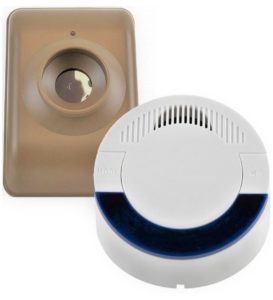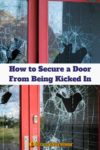We all want to feel safe in our homes, but that isn’t always possible. Between one and 2.5 million burglaries occur annually, of which 55% involve forcible entry.
Kicking down a door isn’t as easy as they make it look in the movies, but if you know where to aim, you can be pretty sure of success.
Regardless of whether it’s made of metal or wood, the weakest point of any door is usually around the lock area. Door frames are also easily compromised, so if you focus on reinforcing those areas, you’ll make it much harder for anyone to force their way in, even if they kick like a mule.
The following 12 tips won’t be enough to turn your home into Fort Knox, but they will secure your door against brute force attacks.
12 Tips on How To Reinforce a Door
#1 Install Stronger Doors
A steel door is much harder to kick in than a wooden door. If a steel door receives a hefty kick, it won’t do much more than dent the door. A wooden one, on the other hand, is liable to splinter.
If you like the look of a wooden door but want better security, opt for one with a hardwood interior and a glass-reinforced plastic coating. This composite material is much stronger than a standard timber door and doesn’t require much maintenance.
#2 Install a Steel Security Grille

Glass sliding doors are some of the hardest to protect against forced entry. Attaching a shatterproof film to your doors can help slow down an intruder, but it’s unlikely to stop them altogether.
A steel security grille won’t stop a burglar completely, but it will help minimize your losses, slowing the thief down long enough for your security system to alert the police.
Steel security grilles also look intimidating enough to deter opportunistic attacks on your home. They’re also easily customizable and could help reduce your home insurance payments.
#3 Reinforce your Doorframe
If your doorframe is rotting, it doesn’t matter how strong your door is. A violent kick aimed at the lock can easily shatter the frame, making your steel door completely ineffective.
Doorframe reinforcements and jamb shields are inexpensive but effective. These shields attach to the door jamb, the flat part that runs up either side of the frame. Once in place, they provide lasting support for the door and the frame.
Simple to install, jamb shields reinforce the most vulnerable areas of your door, like the hinges and locks.
#4 Install Door Armor
Door armor consists of five pieces of steel designed to strengthen critical areas of your door, making it less vulnerable and delaying anyone who attempts to force their way in.
Using galvanized steel to reinforce the jamb, Door armor transforms the weakest point of your door into a kick-resistant barrier.
In addition to a jamb shield, Door armor includes two door shields that you install over the existing latch or strike plates. This is where the door latch is situated and is a notoriously vulnerable spot.
The door shields will hold the latch in place, even if the door’s leading edge is compromised.
Door Armour’s final nail in the burglar’s coffin is a patented hinge shield that strengthens the point where the door attaches to the frame.
The company that manufactures Door Armor, Armor Concepts, is so confident about its product that it offers a refund to any customer whose reinforced door is kicked in. Having watched this video, I’m not surprised.
#5 Use a Door Security Bar
- Horizontal bar: Fits across your existing door and is held in place by stainless steel screws.
- Vertical bar: Turns the horizontal force of a kick into a vertical force that anchors it in place, making it impossible for a burglar to push their way in.
A horizontal bar like this one is an effective deterrent; installation can take a few hours and is only suitable for inward-opening doors.
On the other hand, a vertical bar takes no time to install, is fully adjustable, and, if you opt for the Buddybar model, can withstand up to 2,560 lbs of force.
#6 Get a Door Jammer
Like a security bar, a door jammer takes just seconds to install and, once in place, creates a vertical force that prevents the door from being forced open.
You can use this pocket-sized door jammer to increase security while traveling or prevent intruders from entering your home.
#7 Install a Deadbolt
You can only open a deadbolt lock with a key, meaning that even the most experienced burglar won’t be able to jimmy it with a credit card or knife.
Both single and double-cylinder deadbolts offer excellent security. With a double-cylinder deadbolt, you need a key to unlock from both sides. A single-cylinder version, however, has a thumbpiece on the inside instead. As a result, the single-cylinder deadbolt is safer as it provides an easy escape route in case of fire.
The most advanced deadbolts on the market are now Wi-Fi enabled, so you can use your smartphone or laptop to unlock your door remotely. Not only will this keep intruders out, but it also means you can get inside quickly should you be in danger.
A high-quality deadbolt can withstand the force of a kick and protect your home and its contents against forced entry.
#8 Utilize Motion-Activated Technology

No amount of camera footage can prevent a door from being kicked in, but it can alert you to an intruder so you can call the police before he even starts his assault on your front door.
See our guide to the best motion sensor alarms.
#9 Invest in Smart Locks
Gain access to your home via a keypad or remotely from your phone, so you never have to worry about losing your keys. You can remotely monitor some models, receiving notifications whenever the lock is activated.
Combined with single-cylinder deadlock technology, a smart lock becomes one of the most effective ways to prevent a burglar from entering your home.
#10 Use a Door Reinforcement Lock
It is secured onto the doorframe with 3″ screws and prevents the door from being forced inward. The spring-loaded design makes these nifty gadgets tamper-proof while protecting your door against forced entry and lock picking.
#11 Strengthen the Hinges
The video shows just how flimsy many door installations are. You make your door harder to kick in simply by replacing the screws that hold the hinges in place.
A 3″ screw is long enough to attach the hinges to the wall, as well as the frame, making your door sturdier and more secure.
#12 Replace the Bolt Strike Plate
The bolt strike plate acts as an anchor plate for the entire door and reinforces the frame by engaging the deadbolt and keeping it securely locked.
Conclusion
Even if you only apply one or two of the methods above, your door will be able to withstand a lot more battering than it could before. Utilize all of them, and it will withstand the heftiest of kicks.
Read more about the best ways to protect and defend your home.










As a retired cop who did a lot of raids on dope houses, here’s a few tips. If you plan to put a heavy-duty door up, ALWAYS install a heavy duty door frame, hinges, and long deadbolt locks to go with it. One guy trying to kick in a door like that will wear himself out before he gets in through the door.
Two people on a two-man ram can do some serious work on a heavy duty door, especially if stuck on a crappy frame. BTDT. The first time we use our new two-man ram on a heavy door, we blew it completely out of the frame and most of the way across the living room. It landed on top of the supposed guard pitbull, who screamed in terror and ran away never to be seen again. Terrified the supposed human occupants too, but we felt more sorry for the dog.
Also, having investigated many breaking and enterings, I can confirm that the primary entrance choice for most B&E men is through a door, mostly the front door. Faster and safer (less likely to get cut up on glass like you can going through a window).
When we raided a house with a regular door, a one-man ram easily did the trick. Sometimes a good old-fashioned fire department-style Haligan tool worked fine, or a 16-lb sledgehammer. But, we, the police had the tools and law to putz around and making noise. The B&E man wants in as fast and as quietly as possible with minimal tools. Don’t make his job easy.
Awesome advice. Thanks for the comments.